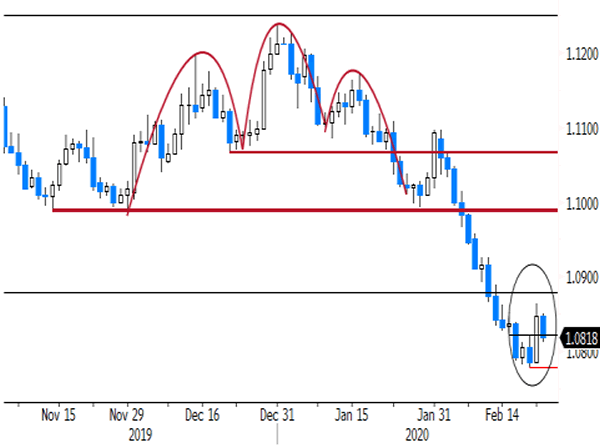- Rates: US 30-yr yield hits all-time low
A correction on US stock markets and a sub-50 US composite PMI reading pulled the US 30-yr yield to an all-time low while the 10-yr yield tested the 2019 low. The rapid spreading of corona cases outside of China hurts risk sentiment this morning. Core bonds profit. This week’s low-profile eco calendar suggests that risk sentiment/corona will be pulling the strings. - Currencies: corona complicates FX reaction function
The EMU PMI’s didn’t help EUR/USD Friday, but US PMI’s unexpectedly hammered the dollar. This morning, the spreading of corona is sending conflicting signals for global FX trading. The yen lost some of its safe haven appeal. The spreading of corona in Italy is a euro negative, but the dollar will probably lose interest rate support due to the risk-off.
The Sunrise Headlines
- WS grinded lower on Friday as worries over the coronavirus outbreak intensified and data (PMIs) disappointed. The Nasdaq (-1.79%) underperformed. Asian markets are posting steep losses. South Korea underperforms (-3.57%).
- A surge of coronavirus cases outside mainland China (South Korea, Italy, etc.) continues to rattle investors. SK raised the disease alert to the highest level after a 20-fold increase in cases and warns its fragile economy is under threat.
- With 88% of precincts reported, Bernie Sanders has won the Nevada caucuses by a large margin, cementing his front-runner status in the US democratic presidential race. Biden ended second, followed by Buttigieg and Warren.
- German Chancellor Merkel’s CDU party plunged and came third (11.2%) in a state election in Hamburg. The Social Democrats (SPD) secured a clear victory (38.6%). The Green party was the biggest gainer and ended second (24.2%).
- G-20 finance ministers and central bank heads called for a coordinated response to the coronavirus epidemic, which the IMF forecasts to curtail China’s growth by 0.4% to 5.6% and world growth by 0.1% to 3.3%.
- The Fed’s Brainard called for adopting new strategies to achieve the Fed’s twin goal of maximum employment and 2% inflation. She advocated for a flexible inflation target that allows for temporary inflation shortfalls and overshoots.
- In today’s economic calendar we look out for Germany’s Ifo gauges. The NABE conference kicks off in Washington. Speeches from the BoE’s Haldane and the Fed’s Mester are due. Turkey taps the bond market
Currencies: Corona Complicates FX Reaction Function
Corona complicates FX reaction fuction
EUR/USD faced different, conflicting drivers on Friday. EUR/USD initially held near the 1.0778 support as uncertainty on the spreading of corona dominated global sentiment. The EMU February PMIs were better than expected and caused a limited EUR/USD uptick. However, the details were unconvincing. EUR/USD soon returned to the 1.08 area. Later, the focus turned to the dollar as the US currency was hit by an unexpected, sharp decline of the US PMIs. EUR/USD jumped higher to close the day at 1.0847. USD/JPY finished the week at 111.61.
This morning, the spreading of corona is keeping markets in a risk-off modus. South Korea underperforms. The yuan trades rather stable (USD/CNY 7.035 area). Japanese markets are closed. USD/JPY is trading in the 111.60 area. The euro returned a big part of Friday’s rebound as the spreading of corona is becoming a prominent risk to the economy. EUR/USD currently trades in the 1.0820 area.
Today, the German IFO business climate is expected to ease to 95.3 from 95.9. However, the market reaction, especially in case of a positive surprise might be guarded. Corona related headlines will continue to set the tone for trading. EMU but also US futures indicate quite an aggressive further risk-off repositioning. Corona currently gives very conflicting signals for trading in the major FX cross rates. The yen lost its safe haven appeal as markets ponder the impact of the epidemic on the ailing Japanese economy. The spreading of the virus in Italy is also a negative for the euro. At the same time, the USD might lose interest rate support as US yields have more room to decline compared to EMU. This complex might lead to an erratic trading pattern in the likes of EUR/USD and USD/JPY. The EUR/USD technical picture deteriorated substantially of late. The 1.0778 level was tested last week, but survived. There is no trigger to fight the EUR/USD downtrend yet, but the pace of the decline is slowing, at least temporarily.
Better than expected UK PMIs last Friday also didn’t bring any lasting support for sterling. EUR/GBP hovered in the 0.8345/85 area. Sterling apparently has discounted the prospects of an economic rebound after the December election. Today, there are no important UK eco data. We don’t see much reason for sterling outperformance in a risk-off context. So, more sideways trading in the EUR/GBP 0.83 big figure might be on the cards.
EUR/USD: EMU PMIs don’t trigger big euro rebound, but 1.0778 support survives














